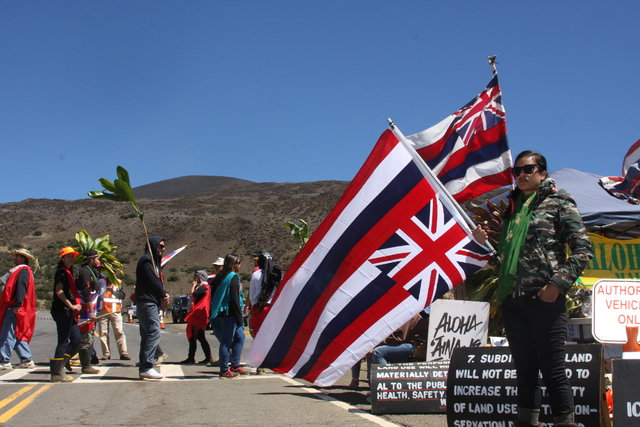Hoomakaukau, the Hawaiian word for prepare or make ready.
That was the message sent out by opponents of the controversial Thirty Meter Telescope following an announcement that the observatory plans to resume construction Wednesday morning of the $1.4 billion project near Mauna Kea’s summit.
Opponents say they have every intention of standing their ground and stopping TMT crews — again.
“Absolutely nothing has changed,” said Kahookahi Kanuha, adding he and others “will be ready.”
In a statement released late Saturday, Henry Yang, chair of the TMT International Observatory Board, said the decision to move forward was made after more than two months of consultation, education and dialogue with many stakeholders.
“Our period of inactivity has made us a better organization in the long run,” he said. “We are now comfortable that we can be better stewards and better neighbors during our temporary and limited use of this precious land, which will allow us to explore the heavens and broaden the boundaries of science in the interest of humanity.”
Wednesday will mark 91 days since tractor trailers carrying heavy equipment ascended the mountain’s summit to begin pre-construction of what will become one of the world’s largest telescopes, sparking protests that ultimately brought the project to a standstill. The situation escalated April 2 when 31 people were arrested for blocking construction workers from accessing the site at 13,150 feet above sea level.
Since then, a small group of protesters, mostly Native Hawaiians who call themselves protectors of the mountain they consider sacred, have maintained a constant, 24-hour presence at an unauthorized camp outside the Visitor Information Station, preparing for the day TMT comes back to build.
Kanuha, a protest organizer who was among those arrested in April, said TMT’s announcement was peculiar, disappointing and upsetting, but not unexpected.
As for what can be expected from his group Wednesday, Kanuha said more of the same — kapu aloha and peaceful resistance.
“We plan to be there, like we have been for the passed 80 some-odd days,” he said. “We don’t want them to build. We don’t want to allow them to commit desecration on the mountain.”
And if that means being arrested a second time, so be it, he said.
During a press conference May 26, Gov. David Ige outlined his vision for better stewardship of Mauna Kea, saying Hawaii has in many ways failed the mountain, and promised to protect both the rights of TMT to proceed with construction and opponents to peacefully protest.
Yang said TMT plans to first investigate and assess any possible oil leakage and ensure that proper maintenance of machines and equipment is provided. After that, the observatory plans to repair and install fencing around the property.
“As we proceed, TMT is open and willing to allow cultural practitioners in the area of the construction site to continue customary and traditional practices,” he said. “Allowing this practice to continue to occur will require further dialogue and mutual agreement to work out the details in order to establish a cooperative and harmonious environment for all parties.”
After an exchange of trespass notices earlier this month — first, from security guards to project opponents, and later vice versa — protesters were allowed back onto the TMT site. In a short video posted June 15 to Facebook, about a dozen protesters can be seen entering the area, near the summit of Mauna Kea, while security stationed at the entrance stood aside.
In an email last week, Caroline Witherspoon, president of Becker Communications, a public relations firm hired by TMT to handle media inquiries, confirmed no additional trespassing notices had been issued since June 8, when Kanuha and others entered the property to pule and chant.
Despite the months-long protest, which has made waves on social media and garnered support from numerous celebrities, including Jason Mamoa and St. Louis Cardinals baseball player Kolten Wong, Yang said TMT has plenty of backers.
“We look forward to a positive relationship with all Hawaiians, while we understand that the majority of Hawaii’s people are supporting the TMT project,” he said. “We deeply respect and are mindful of those who have concerns, and yet, we hope they will permit us to proceed with this important task while reserving their right to peaceful protest.”
Hawaiian activist Walter Ritte, who was en-route to the Big Island on Sunday, said Yang’s comment about TMT’s level of support is a “hell of a statement,” and that this issue has united the Hawaiian community like never before.
“That’s what they’re selling,” Ritte said of TMT. “They’re selling that they have a lot of support.”
If TMT does try to build Wednesday morning, Ritte said he expects confrontation and additional arrests.
In a response to TMT’s announcement Saturday, the Sacred Mauna Kea Hui reaffirmed its commitment to “protect the Mauna with our bodies” and to “continue to call on its worldwide and local support for all protection efforts.”
Meanwhile, Yang said that in an effort to be sensitive to and observant of the Native Hawaiian host culture, TMT will “deepen its knowledge of the cultural, ecological and spiritual aspects of the mountain and continue to learn how to better respect and appreciate Mauna Kea’s important cultural areas.”
As of Sunday, an online petition urging the Hawaii governor to stop TMT construction and the arrests on Mauna Kea had received more than 61,000 signatures.
Meanwhile, the state Supreme Court has agreed to hear an appeal of TMT’s conservation district land use permit. Kealoha Pisciotta, one of the plaintiffs, said oral arguments are scheduled for Aug. 27.
Email Chris D’Angelo at cdangelo@hawaiitribune-herald.com.





